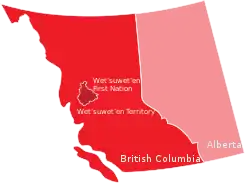Wetʼsuwetʼen First Nation
The Wetʼsuwetʼen First Nation is a Wetʼsuwetʼen First Nations band located outside of the village of Burns Lake, British Columbia, Canada.[1][2] It was formerly known as the Broman Lake Indian Band and is still usually referred to as Broman Lake although this is no longer its official name.[3] Its members speak the Wetʼsuwetʼen dialect of Babine-Witsuwitʼen, a Northern Athabaskan language. The main community is on Palling Indian Reserve No. 1.
 Wetʼsuwetʼen First Nation location in traditional Wetʼsuwetʼen territory within British Columbia, Canada | |
| People | Dene |
|---|---|
| Province | British Columbia |
| Land | |
| Main reserve | Palling 1 |
| Other reserve(s) |
|
| Land area | 7.008 km2 |
| Population (2020) | |
| On reserve | 83 |
| On other land | 11 |
| Off reserve | 162 |
| Total population | 256 |
| Government | |
| Chief | Maureen Luggi |
| Council |
|
| Tribal Council | |
| Carrier Sekani Tribal Council | |
| Website | |
| wetsuwetenfirstnation | |
As of March 2017, the Nation had 257 registered members, with 85 members living on the First Nation's own reserve.[4]
The Nation is a member of the Carrier Sekani Tribal Council[5] and of the Broman Lake Development Corporation.
The Wetʼsuwetʼen First Nation was formerly part of the Omineca Band. In 1984, the Omineca Band split into the Broman Lake and Nee-Tahi-Buhn Band. The Skin Tayi band later split off from Nee-Tahi-Buhn.
Other Wetʼsuwetʼen First Nations bands include the Burns Lake Indian Band, Hagwilget Village First Nation, Skin Tyee First Nation, Nee-Tahi-Buhn Band and Witset.
References
- Canada, Government of Canada; Indigenous and Northern Affairs (2013-02-06). "Wet'suwet'en First Nation". www.aadnc-aandc.gc.ca. Retrieved 2019-01-08.
- "Office of the Wet'suwet'en". www.wetsuweten.com. Retrieved 2019-01-12.
- "Browman Lake Community, Wetsuweten". www.wetsuweten.com. Retrieved 2019-01-12.
- Branch, Government of Canada; Indigenous and Northern Affairs Canada; Communications (2008-11-03). "Home". fnp-ppn.aandc-aadnc.gc.ca. Retrieved 2019-01-08.
- Branch, Government of Canada; Indigenous and Northern Affairs Canada; Communications (2008-11-03). "Home". fnp-ppn.aandc-aadnc.gc.ca. Retrieved 2019-01-08.